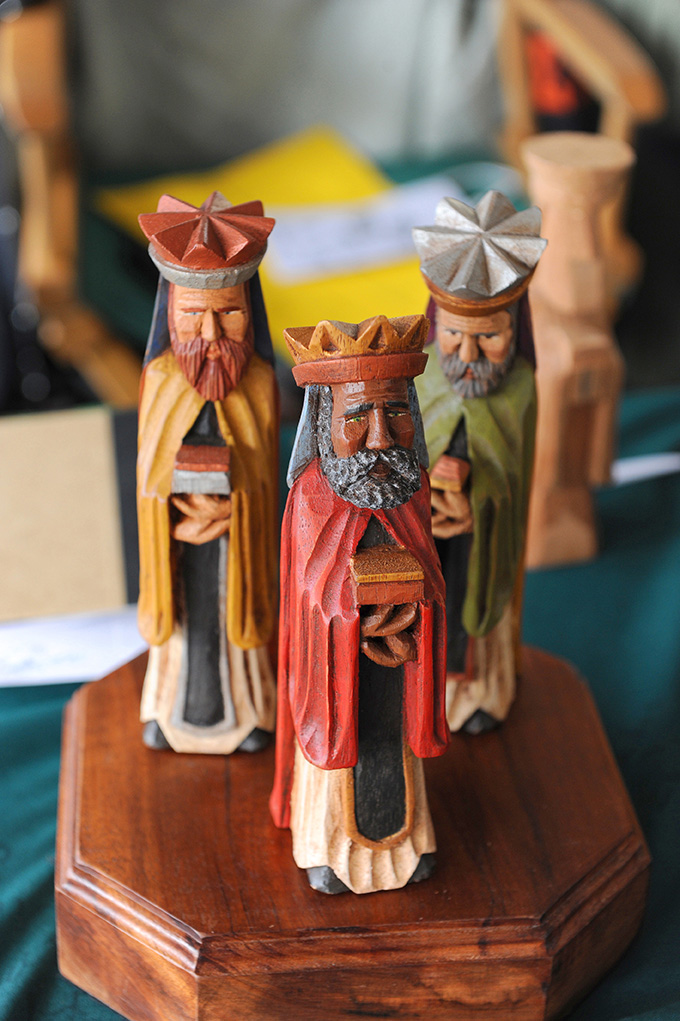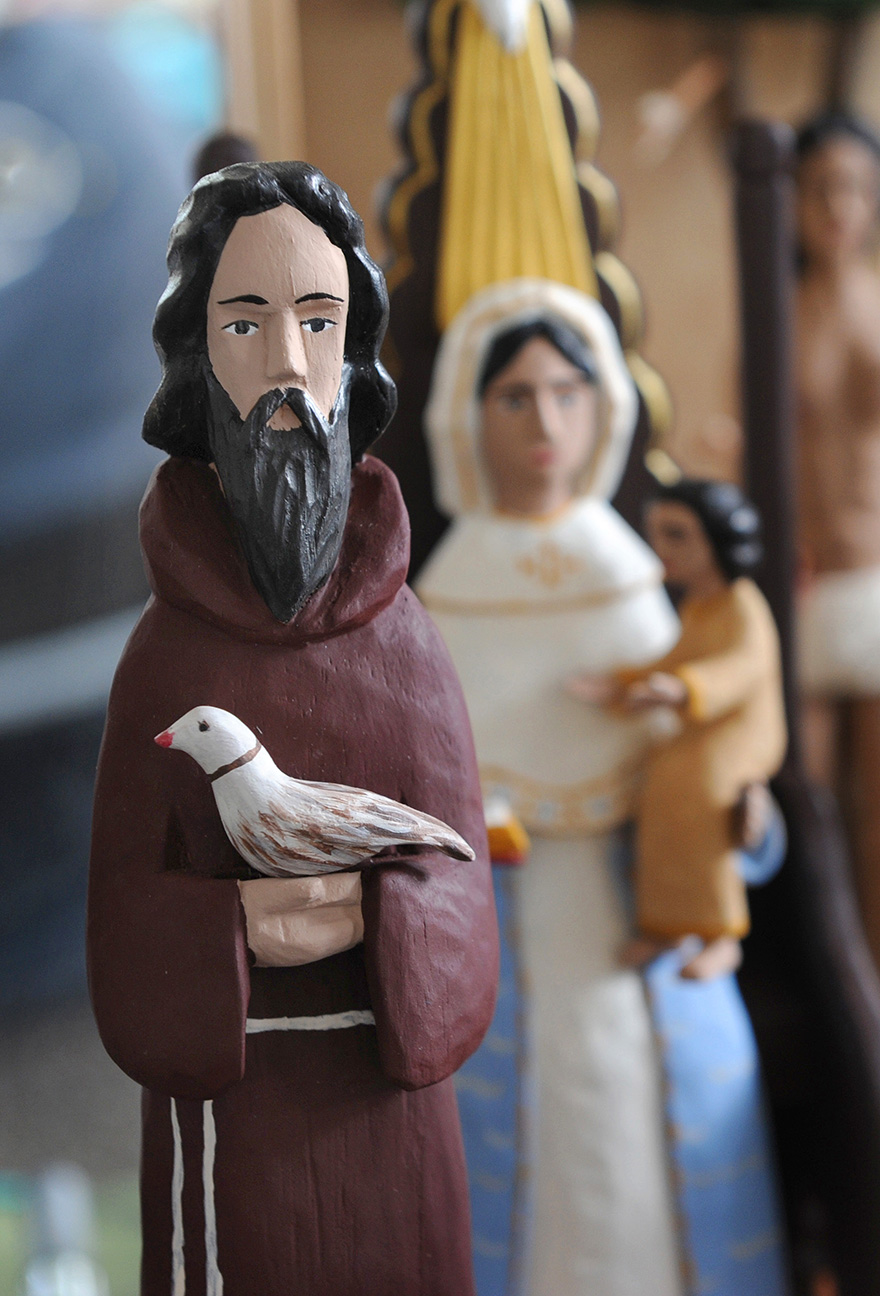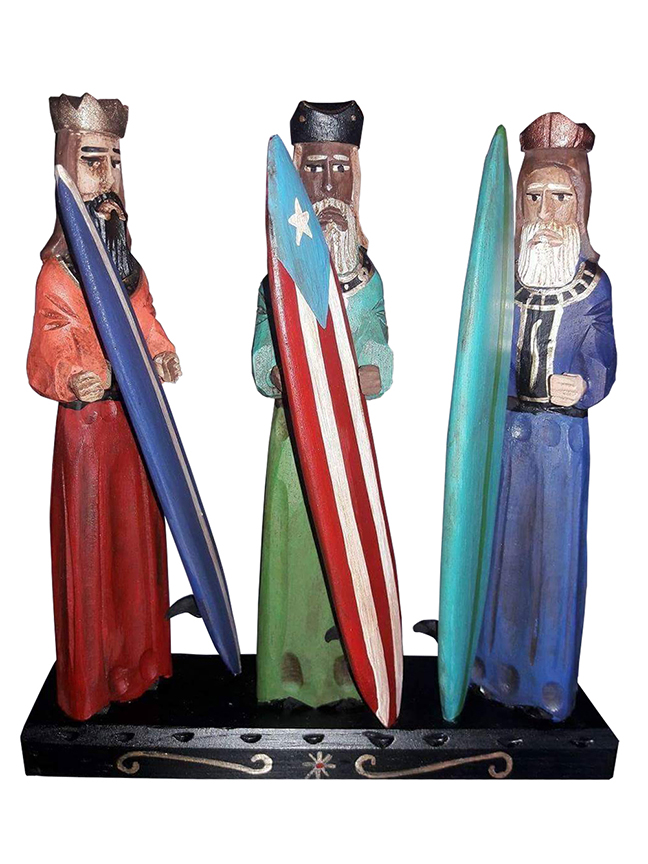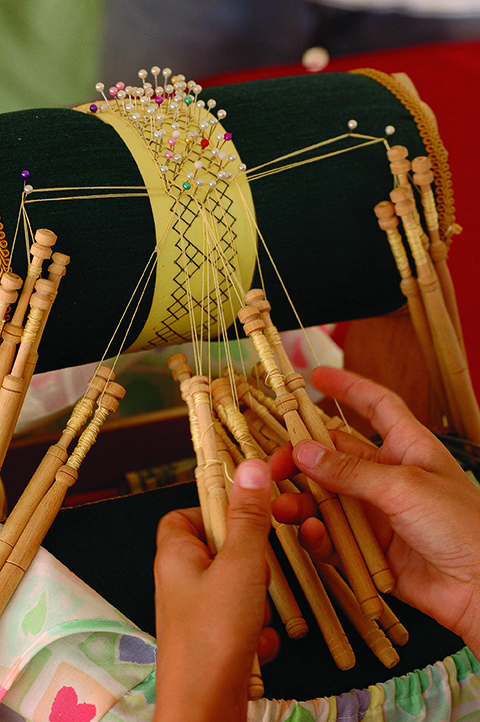No visit to the island of enchantment would be complete without taking a deep dive into Puerto Rico’s colorful folklore and traditions, and there’s no better way to experience this than through the rich talent fits artisans and their stunning crafts.
Make sure to explore crafts like the exquisitely carved Santos figures, delicate Mundillo lace fit for a queen, horns-bedecked carnival masks, and the wooden mortar and pestle known as pilons, and numerous other works of art produced by these skilled crafts persons. Items span home decorations in clay, wood, paper and metal; hammocks; greeting cards; jewelry; clothing; tote bags; foods like sweets and rum cake; musical instruments such as guiros; cigars; and knick knacks. All locally produced, all mostly made by hand.
From San Juan to Rincon, Ponce to Humacao, you will see talented artisans sell their beautiful wares at street stands, during crowded fairs and at popular parks and beachfront. There are also stunning craft stores and boutiques and art galleries across the island, especially around renovated downtown areas and at shopping malls.
Old San Juan, however, is a must-visit for the craft aficionado, with some of the finest crafts shops in the Caribbean. At Mundo Taino (Taino World) and Puerto Rico Art & Crafts the full diversity of small-scale production is in full display souvenir shops and crafts specialty shops are not the sole places to find Puerto Rican crafts. Craftspeople can be found most days in different sections of Old San Juan. On weekends, there’s the Plaza La Casita market next to Pier 1 and the Paseo La Princesa Market, both of which are sponsored by the Puerto Rico Tourism Co. Maria V. Rivera Delgado, a tourism administration official, said some 38 artisans show their wares along the Paseo, a wide, scenic promenade that runs along San Juan Bay and the ancient ramparts and leads up to San Juan Gate, one of five entries that once led into the city. The markets are held Saturday and Sunday from 10 a.m. to 8 p.m.
Craft making in Puerto Rico is a rich tradition hewing to time-honored ways but that’s not to say it isn’t stepping up to the times. In fact, some of the crafts being produced these days by ceramists look more like art than artisanal objects. Some craftspeople are dropping autochthonous imagery and instead concentrating on more universal themes. While cheap and crudely made crafts are still to be found in souvenir shops, local production mostly reflects a high level of workmanship and skill. Tony Amador, the owner of Puerto Rico Arts & Crafts, which his mother Charm Amador founded in the late 70s, said the field is changing, with some artisans now incorporating technology into their process. It’s all an outgrowth of competition, the ubiquity of the internet which exposes artisans to new ideas and the artisans’ own evolution, he said.
One craft that remains strongly rooted in age-old tradition is Santos, Puerto Rico’s greatest contribution to the plastic arts, according to some art historians. These hand-carved figures, representing patron saints, angels, and Marian titles, have achieved such a cultural standing that antique Santos are now considered works of art and can be found in private collections as well as museums in Puerto Rico and the U.S., including the National Museum of American History of the Smithsonian Institution in Washington, D.C.
Santos are found in all the countries that were at one time part of the vast Spanish empire. According to historians, Puerto Rico’s Santos may also have a link with the Tainos, the island’s indigenous people. It was their custom to keep small statues as objects of veneration in tribal villages. Carved in stone or wood, the statues — known as Cemi — represented a god, spirit or ancestor.
The men and women who carve santos are called santeros and santeras. Their tools are basic: a knife and paint to add color to the figure. The best of these artisans are considered masters and it has become their practice to sign each piece as proof of its value. This was not always the case. Juan Botello, whose Botello Gallery carries antique santos made between 1850 and 1950, noted that santos dating from 1800 to 1900 were not usually signed and are characterized by a primitive style that contrasts the classic Spanish Santos made in a more realistic vein.
Santeros tend to stick to a single figure but when they resort to a group scene it is usually to portray The Nativity or The Three Kings. Religious figures are usually identifiable through the symbols they carry. For example, St. Joseph might be depicted holding the child Jesus in one arm and a staff in the other while St. Francis is usually portrayed with birds and animals.
The allure of the Santo is essentially its pared down simplicity. As one writer put it, “Santos are made with a humble touch and homespun beauty.” In addition to Botello, on Cristo St., another old San Juan store that carries Santos is Antiguedades Olé, on Fortaleza St. Its Santos are between 80 to 100 years old.
Masks have always fascinated people and Puerto Rico’s caretas certainly stand out for their flamboyance and wild colors. The masks are worn at carnival times by vejigantes, revelers who wear bat-winged jumpsuits and roam the streets singly or in groups. According to Amador, of Puerto Rican Art & Crafts, two types of masks are made in Puerto Rico, each tied to a different part of the island. The ones made in the southern town of Ponce, a major center for this craft, are made out of papier maché while those made in Loiza Aldea, an area near San Juan known for its artisans and dancers, are fashioned out of corn husks.
Though differently crafted, the mask portrays the same type of devilish figure. Its main features are a leering mouth ringed by fangs, bulging eyes, and long horns that some artisans render as wavy Medusa-like tentacles.
Scary-looking, sure, but fun, the masks are painted in vivid, contrasting colors set off by pointillist details for greater decorative effect; the palette takes in practically all hues though the more traditional masks lean towards black, red and yellow, colors associated with hell, to which the masks are believed o allude.
According to historians, carnivals and masks are rooted in medieval Spain where, starting in the 17th century, processions of marching devils were held to scare sinners into returning to church. The vejigantes surfaced in Spain as part of the patronal festival of Santiago (St. James); they were meant to be a representation of the devil in the fight of good versus evil but also of the “evil moors.” In Puerto Rico, these Spanish traditions melded with others brought in by African slaves.
To experience the thrill of vejigantes in full mask regalia, consider attending the Fiesta de Santiago Apostol, or St. James Festival, held yearly in Loiza Aldea during the month of July. More masks are to be seen at the Ponce carnival. It has been running for more than 250 years but you’ll have to wait for the next edition in 2019 as the event is typically held the week ending on the day before Ash Wednesday.
One craft that seemed headed towards extinction has instead experienced a welcome revival, bringing it back to the forefront. It is the ancient art of mundillo or bobbin lace making.
Mundillo is a decorative lace made by braiding and twisting lengths of thread bound on bobbins. The word mundillo, which means little world, refers to the cylindrical pillow on which the weaving is kept in place. The finished product can be used as clothing, border finishes for tablecloths and handkerchiefs, or to decorate shirt collars, dresses and wedding gowns.
While some claim Mundillo lace is made only in Spain and Puerto Rico. Benito “Mokay” Hernandez Vale, founder and director of the Mundillo Museum in Moca, begs to differ. He said this type of lace making is popular in many European countries and likely originated between the third and seventh century A.D. though it could even be older as bobbin lace has been found in ancient pharaonic tombs.
According to Hernandez, interest in the craft has been growing over the past 15 years and he estimated that more than 3,000 people on the island are now practicing it, and it’s not just women.
The Mundillo Museum, located in a one-story building in the heart of Moca, on Puerto Rico’s north-western side, was inaugurated in July 2005. Its collection of hundreds of lace items includes a tablecloth from 1896 and, its most valuable piece, an 8 foot high by 4 foot wide lace map of the town of Moca made by a group of lace makers in 2014 to celebrate the institution’s 10th anniversary. The museum is open Monday through Saturday from 8 am to 2 pm (telephone: 787-877-3815).
In San Juan, mundillo products can be found at Plaza Las Americas where lace maker Mary Quiñones runs a cart business named MQ Mundillo de Moca on the ground floor of the shopping center, near the Banco Popular branch and the tower. Items for sale include handkerchiefs and baby clothing, bibs and blankets made by her family workshop.
No self respecting Puerto Rican kitchen would be caught without a pilón. The mortar and pestle has a long history dating back to the island’s indigenous people. But unlike the small-sized mortars most people are familiar with, the ones used by the Tainos were waist high receptacles made from hollowed out tree trunks. The cavity, measuring approximately 25 inches in diameter, was burned out. The large pestle, or maceta, that went along with the large mortar were also carved out of trees. Tainos used the pilón and the maceta to mash corn, spices, and medicinal herbs.
Today, this kitchen utensil comes in handy to grind herbs for sofrito (the base for delicious rice, beans and stews), to prepare spice mixes and condiments, and for all sorts of crushing of garlic, plantains, corn and coffee. It’s the key tool to make mofongo, one of Puerto Rico’s most iconic dishes consisting of mashed plantains stuffed or accompanied by meat, fish or fowl.
The typical pilón is made from the wood of the Caoba or Guayacan trees, fine and durable hardwoods native to the island. Artisan Antonio Rivera, whose workshop is in the town of Morovis, in the island’s central region, said people tend to prefer pilones made out of caoba for its warm, red color. He has been making pilones since he was 13, a craft he learned from his carpenter dad. The pilones for kitchen use typically range in size from 6 to 10 inches high; Rivera also makes them larger by request. He can be contacted through his Facebook page under the heading Pilones de Puerto Rico.
Crafts, a source of independent jobs for countless Puerto Ricans, are an expression of a people’s artistry and history. Making an object by hand is an activity that takes time and effort. Either as a gift for family and friends or as a keepsake of a memorable trip, a crafts item is a small treasure.









